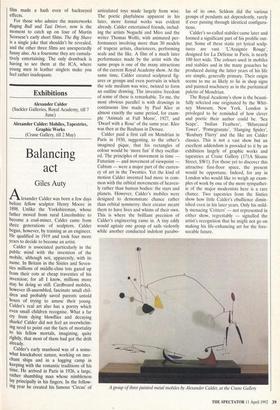Exhibitions
Alexander Calder (Sackler Galleries, Royal Academy, till 7 June)
Alexander Calder: Mobiles, Tapestries, Graphic Works (Crane Gallery, till 2 May)
Balancing act
Giles Auty
Alexander Calder was born a few days before fellow sculptor Henry Moore in 1898. Unlike the Yorkshireman, whose father moved from rural Lincolnshire to become a coal-miner, Calder came from three generations of sculptors. Calder began, however, by training as an engineer. He qualified in 1919 and took four more years to decide to become an artist.
Calder is associated particularly in the public mind with the invention of the mobile, although not, apparently, with its name. In Britain in the Sixties and Seven- ties millions of middle-class tots gazed up from their cots at cheap travesties of his invention; for all I know, millions more may be doing so still. Cardboard mobiles, however ill-assembled, fascinate small chil- dren and probably saved parents untold hours of trying to amuse their young. Calder's real art also has a poetry which even small children recognise. What a far cry from dying blowflies and decaying sharks! Calder did not feel an overwhelm- ing need to point out the facts of mortality to his fellow mortals, imagining, quite rightly, that most of them had got the drift already.
Calder's early manhood was of a some- what knockabout nature, working on mer- chant ships and in a logging camp in keeping with the romantic traditions of his time. He arrived in Paris in 1926, a large, rather shambling man whose nimbleness lay principally in his fingers. In the follow- ing year he created his famous 'Circus' of articulated toys made largely from wire. The poetic playfulness apparent in his later, more formal works was evident already. Calder entertained friends, includ- ing the artists Noguchi and Miro and the writer Thomas Wolfe, with animated per- formances involving more than 30 models of trapeze artists, charioteers, performing seals and the like. A film of a much later performance made by the artist with the same props is one of the many attractions of the current Royal Academy show. At the same time, Calder created sculptural fig- ures or groups and even portraits in which the sole medium was wire, twisted to form an outline drawing. The inventive freedom of some of these is remarkable. To me, the most obvious parallel is with drawings in continuous line made by Paul Klee at almost exactly the same period, for exam- ple 'Animals at Full Moon', 1927, and `Dwarf with a Rose' of the same year. Klee was then at the Bauhaus in Dessau.
Calder paid a first call on Mondrian in Paris in 1930, suggesting, to the other's imagined pique, that his rectangles of colour would be `more fun' if they oscillat- ed. The principles of movement in time — Futurism — and movement of viewpoint — Cubism — were a major part of the curren- cy of art in the Twenties. Yet the kind of motion Calder invented had more in com- mon with the orbital movements of heaven- ly rather than human bodies: the stars and planets. However, Calder's mobiles were designed to demonstrate chance rather than orbital symmetry: their creator meant them to have lives and whims of their own. This is where the brilliant precision of Calder's engineering came in. A tiny eddy would agitate one group of sails violently while another conducted indolent parabo-
las of its own. Seldom did the various groups of pendants act dependently, rarely if ever passing through identical configura- tions.
Calder's so-called stabilewcame later and formed a significant part of his prolific out- put. Some of these static yet lyrical sculp- tures are vast. 'L'Araignee Rouge', designed for La Defense in Paris, is nearly 100 feet wide. The colours used in mobiles and stabiles and in the many gouaches he produced during the latter years of his life are simple, generally primary. Their origin seems to me as likely to lie in shop signs and painted machinery as in the puritanical palette of Mondrian.
The Royal Academy's show is the beauti- fully selected one originated by the Whit- ney Museum, New York. London is privileged to be reminded of how clever and poetic their author could be. `Sea Scape', 'Indian Feathers', 'Bifurcated Tower', 'Pomegranate', 'Hanging Spider', 'Roxbury Flurry' and the like are Calder classics. This is not a vast show but an excellent addendum is provided to it by an exhibition largely of graphic works and tapestries at Crane Gallery (171A Sloane Street, SW1). For those yet to discover this attractive first-floor space, the present would be opportune. Indeed, for any in London who would like to weigh up exam- ples of work by one of the more sympathet- ic of the major modernists here is a rare chance. Two tapestries from the Sixties show how little Calder's ebullience dimin- ished even in his later years. Only his mild- ly menacing 'Critters' — not represented in either show, regrettably — signalled the artist's recognition that he might not go on making his life-enhancing art for the fore- seeable future.
A group of three painted metal mobiles by Alexander Calder, at the Crane Gallery


















































 Previous page
Previous page